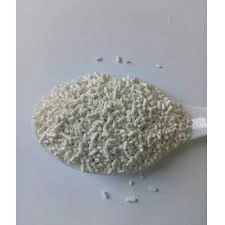
Exploring the Impact of E322 Food Additive on Health and Nutrition
Understanding E322 Lecithin as a Food Additive
In the world of food science, additives play a crucial role in enhancing food quality, preserving freshness, and improving overall taste and presentation. One such food additive is E322, commonly known as lecithin. As a phospholipid derived from various sources, lecithin has gained popularity for its functional properties in a multitude of food products. In this article, we will delve into the origins, functions, safety, and applications of E322 in the food industry.
What is E322?
E322 is a food emulsifier that primarily consists of phosphatidylcholine, a vital component of cell membranes. Lecithin can be extracted from various natural sources, including soybeans, sunflowers, eggs, and canola. Soy lecithin is the most commonly used form due to its availability and low cost. It appears as a yellowish-brown paste or a powder depending on the extraction process and can be processed to meet different specifications needed for food manufacturing.
Functions of Lecithin in Food
The primary role of lecithin as E322 is as an emulsifier—an agent that helps blend ingredients that typically do not mix, such as oil and water. This quality is particularly vital in products like salad dressings, mayonnaise, and chocolate, where a stable blend is essential. Additionally, lecithin helps improve texture and mouthfeel, giving foods a pleasant consistency.
Lecithin also serves as a stabilizer, preventing the separation of ingredients over time. This prolongs the shelf life of processed foods and maintains their visual appeal. Beyond emulsification, lecithin contributes to improved moisture retention and can aid in reducing overall fat content in certain products, allowing for healthier food options without compromising taste.
Another interesting aspect of E322 is its potential as a natural antioxidant. Although not its primary function, lecithin can help protect food from oxidative damage, potentially extending the shelf life of products by inhibiting rancidity.
e322 food additive

Safety and Regulations
The safety of food additives is of paramount importance to regulatory bodies, and lecithin has been deemed safe for consumption by organizations such as the Food and Drug Administration (FDA) and the European Food Safety Authority (EFSA). Studies have shown that lecithin is well-tolerated by most individuals, and any adverse reactions are rare. However, those with specific allergies, particularly to soy or eggs, should exercise caution and consult ingredient labels.
Lecithin's classification as a Generally Recognized As Safe (GRAS) substance allows food manufacturers the flexibility to utilize it in various applications without the need for extensive pre-market approvals. This has led to its widespread acceptance in the food industry.
Applications in the Food Industry
E322 is ubiquitous in many processed foods. You can find lecithin in baked goods, margarine, chocolate products, sauces, dressings, and dairy products. In the baking industry, lecithin enhances dough performance, improves loaf volume, and contributes to a tender crumb structure. In chocolates, it allows for a smoother texture and a glossy finish.
The plant-based food sector has also seen a rise in the use of lecithin, particularly as a vegan alternative to animal-derived emulsifiers. Sunflower lecithin, being non-GMO and allergen-free, stands out as a popular choice among manufacturers catering to health-conscious consumers.
Conclusion
E322, or lecithin, is an essential food additive that provides numerous functional benefits in food processing and preparation. Its ability to act as an emulsifier, stabilizer, and moisture-retaining agent makes it invaluable in enhancing food quality and ensuring a pleasurable experience for consumers. With a strong safety profile and diverse applications, lecithin continues to play a significant role in both the traditional and innovative food landscapes. As the food industry evolves, the utilization of E322 is likely to expand further, supporting the demand for efficient and safe food manufacturing processes.
-
Understanding Synthetic Rubber OptionsNewsApr.27,2025
-
Trichloroisocyanuric Acid: Essential for Clean and Safe WaterNewsApr.27,2025
-
Sodium Dichloroisocyanurate: Key to Safe Water TreatmentNewsApr.27,2025
-
Sodium Acid Pyrophosphate: Essential in Modern Food ProcessingNewsApr.27,2025
-
Essential Water Treatment ChemicalsNewsApr.27,2025
-
Denatured Alcohol and Its Industrial UsesNewsApr.27,2025
-
The Versatile Uses of Sodium BicarbonateNewsApr.24,2025
Hebei Tenger Chemical Technology Co., Ltd. focuses on the chemical industry and is committed to the export service of chemical raw materials.
-

view more DiethanolisopropanolamineIn the ever-growing field of chemical solutions, diethanolisopropanolamine (DEIPA) stands out as a versatile and important compound. Due to its unique chemical structure and properties, DEIPA is of interest to various industries including construction, personal care, and agriculture. -

view more TriisopropanolamineTriisopropanolamine (TIPA) alkanol amine substance, is a kind of alcohol amine compound with amino and alcohol hydroxyl, and because of its molecules contains both amino and hydroxyl. -

view more Tetramethyl Thiuram DisulfideTetramethyl thiuram disulfide, also known as TMTD, is a white to light-yellow powder with a distinct sulfur-like odor. It is soluble in organic solvents such as benzene, acetone, and ethyl acetate, making it highly versatile for use in different formulations. TMTD is known for its excellent vulcanization acceleration properties, which makes it a key ingredient in the production of rubber products. Additionally, it acts as an effective fungicide and bactericide, making it valuable in agricultural applications. Its high purity and stability ensure consistent performance, making it a preferred choice for manufacturers across various industries.











